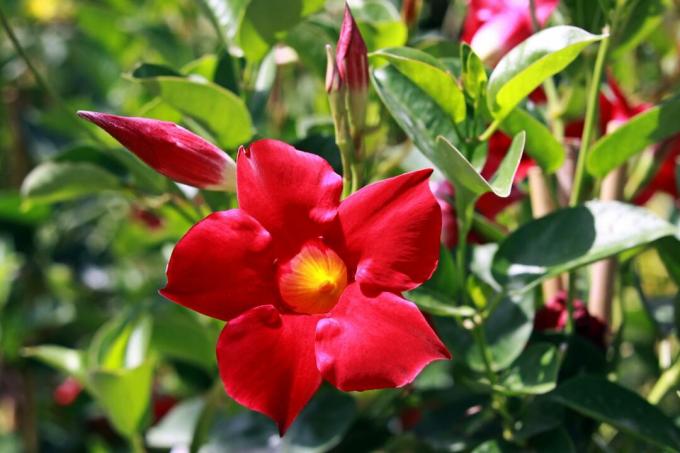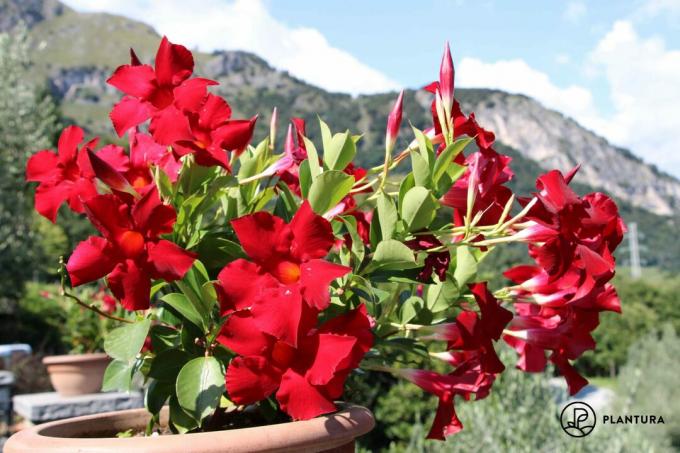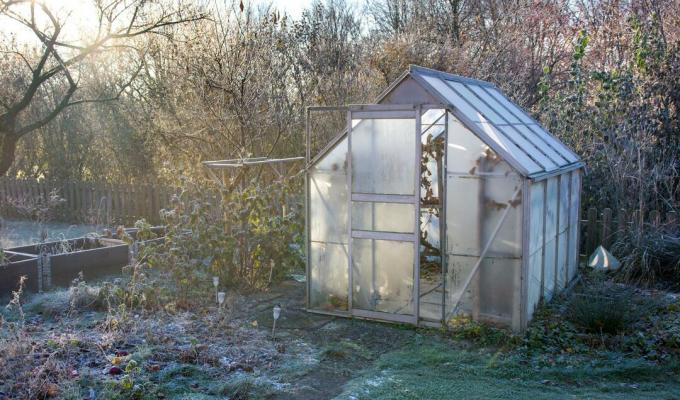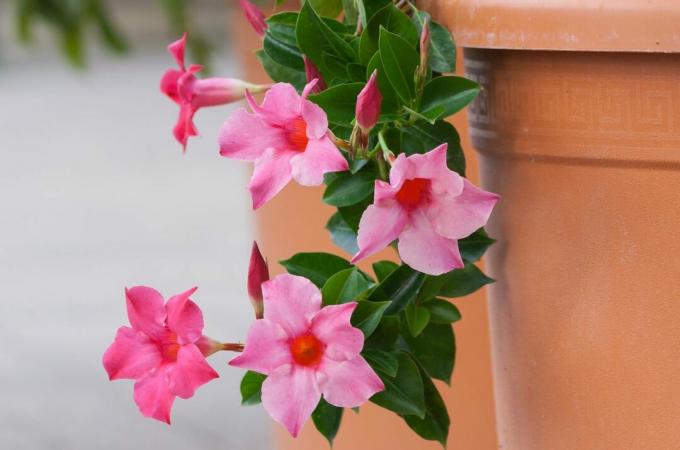The Dipladenia, also called Mandevilla, is usually cultivated as an annual plant in pots. But can the plant also overwinter? We show what you should consider when wintering a Mandevilla.

Whether Dipladenia or Mandevilla (Mandevilla) - what is meant is a beautiful, creeping plant that produces magnificent flowers from spring to late summer. However, when the flowering period is over, many of the plants migrate to the compost. That doesn't have to be the case, however, because the Mandevilla is a perennial plant - provided it survives the cold winter. In order for you to succeed in wintering your Dipladenia, we will tell you in this article when it gets too cold, where the best winter quarters are and how it needs to be looked after in winter.
contents
- Wintering Dipladenia: Are there any hardy varieties?
- Wintering Dipladenia: the right location
- Cut back Dipladenia before overwintering
- Maintain Dipladenia in winter
Wintering Dipladenia: Are there any hardy varieties?
At home in the tropics, the Dipladenia feels most comfortable in the year-round warm and sunny climate. Even temperatures below 8 ° C damage the heat-spoiled plant. The only exception is the hardy Dipladenia species Mandevilla laxa. It is also known under the name "Chilean jasmine" and can defy frosty temperatures down to -5 ° C. For all other Dipladenia species, such as the popular ‘Sundaville’ variety, the following applies: They do not tolerate the cold and are therefore not hardy. Not winter hardy does not mean that the plant cannot be overwintered. Buying flowers and plants only for one season is detrimental to the wallet and is not at all in the interest of sustainability. The Dipladenia can be overwintered without much effort and give you so many years of pleasure.

The most important questions about Dipladenia in winter briefly answered:
- Dipladenia or Mandevilla? - Both names mean the same plant.
- Can Dipladenia be overwintered? - Yes.
- Is the Dipladenia annual? - No, it can be cultivated for several years.
- When does it get too cold in the Mandevilla? - From temperatures below 8 ° C.
- Are there hardy Dipladenia varieties? – Mandevilla laxa The only species that tolerates temperatures down to -5 ° C.
Wintering Dipladenia: the right location
To properly overwinter your Mandevilla, you need an ideal location, the right procedure and appropriate maintenance during the cold season. We explain all of these points in the following sections.
Whether on the terrace, the balcony or in the garden - outside it gets too cold for the Dipladenia in winter. So you have to get the climbing plants into the warm early in autumn in order to overwinter them in the pot. The ideal winter quarters for the Mandevilla is a cold house, for example a frost-free greenhouse or a cold winter garden. Here the plant gets enough light and the temperatures are not too warm. Suboptimal winter quarters for your Dipladenia would be in the warm apartment, for example in the living room, or in the dark cellar. If the Mandevilla gets too warm in winter, it may not bloom for the next year. The temperature is right in the basement or garage, but it's too dark for the sun-drenched plant. Wintering is only possible here with a plant lamp.
Various winter locations for the Dipladenia at a glance:
- Hibernate Dipladenia outside: Not possible
- Wintering Dipladenia in a cold house: ideal
- Hibernating Dipladenia in the living room: Possible, but not ideal
- Hibernate Dipladenia in the basement: only possible with lighting

Cut back Dipladenia before overwintering
You can start preparing for winter as early as autumn. A pruning prepares your Dipladenia well for winter and also brings it into a more compact and space-saving form. If you don't have that much space inside, that's a big advantage. For pruning, the plant is shortened by a third both in height and in width. How to do the Cutting the Dipladenia is the best way to proceed, you can find out in our special article.
Tip: The sap of the Mandevilla is harmful to the skin. Therefore, wear gloves for all care measures.
Maintain Dipladenia in winter
After the pruning, the Dipladenia is ready for its winter quarters. There it should be as bright as possible and stand at a constant temperature between 8 and 10 ° C. There is no fertilization in winter. Water the plant only moderately and as required when the top layer of the substrate has dried off. To ensure a comfortable level of humidity, spray your Mandevilla regularly with a spray bottle. Unfortunately, in winter your Dipladenia offers pests such as mealybugs (Pseudococcidae), Spider mites (Tetranychidae) and Scale insects (Coccoidea) an ideal home. In order to recognize an infestation early enough and to be able to react accordingly, check the plant regularly.
Tip: During the winter, it is not uncommon for your Dipladenia to lose its leaves. In spring these should grow back and the plant will sprout again.
If the Dipladenia has survived the winter well, it should not be overwintered prematurely. Put them out again in May at the earliest, when the temperatures are permanently above 8 ° C.

In a nutshell: Hibernate Dipladenia and care for it in winter:
- Cut back before winter
- Optimal temperature: 8 - 10 ° C
- As bright as possible
- Do not fertilize
- Pour moderately
- Moisten with a spray bottle
- Check for pests regularly
- Wintering in May at the earliest
Other tropical plants - such as the convertible rose - can also be successfully overwintered. You can find out everything about this in our special article on Convertible roses in winter.
Would you like to take a look behind the scenes at Plantura? Then follow us on Instagram! There we share our best tips and tricks about sustainable gardening every day and take you with us when it comes to developing new products.
planturagarden
For more sustainable plant splendor 🌿
Our products come to you with ❤️
Share your little plants under #PlanturaPlants 📸










